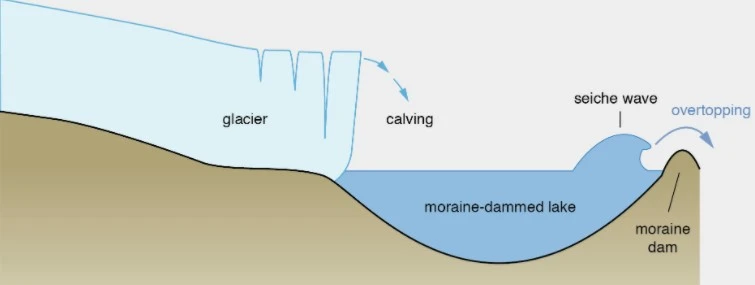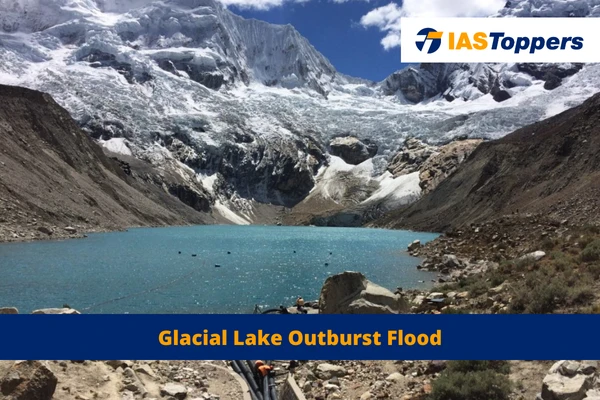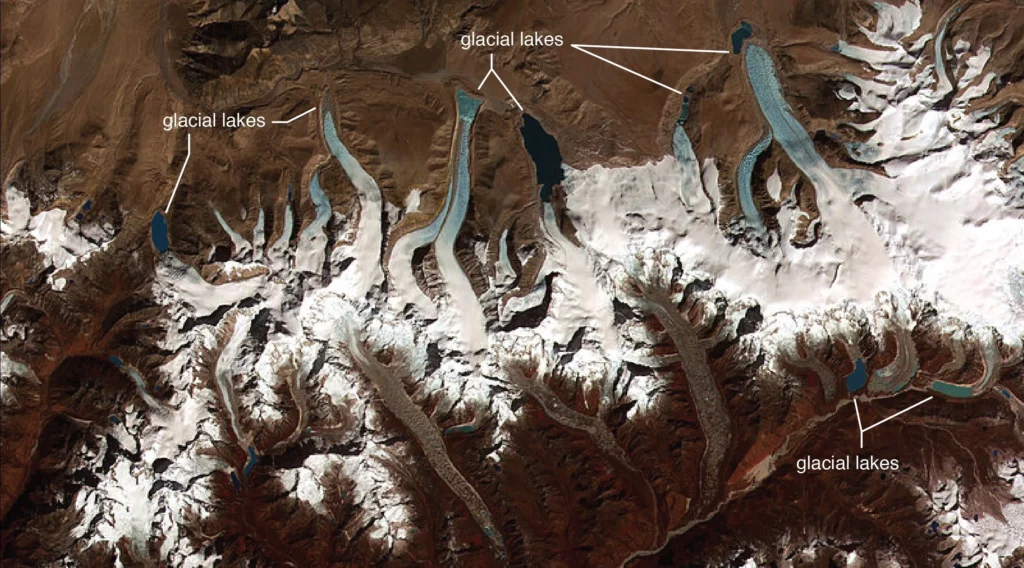A Glacial Lake Outburst Flood (GLOF) is a catastrophic event that occurs when a glacier-dammed lake overflows, releasing a significant amount of water and debris. In light of global warming and increasing glacier melt, understanding and managing GLOFs is crucial for disaster management, particularly for countries in high-risk areas such as the Himalayan region. This article discusses about how GLOFs and glacial lakes form, the risks they pose, instances of GLOFs in India, and guidelines set by the National Disaster Management Authority to manage these events. This is an important topic for GS Paper-3 Disaster Managementof UPSC CSE Exam.
Table of Content
- What is Glacial Lake Outburst Flood (GLOF)?
- How does Glacial Lake Outburst Flood occur?
- How does Glacial Lake form?
- Threats posed by Glacial Lake Outburst Flood
- Instance of Glacial Lake Outburst Flood in India
- National Disaster Management Authority Guidelines on GLOFs
- Suggestions to reduce impact of Glacial Lake Outburst Flood
What is Glacial Lake Outburst Flood (GLOF)?
- A Glacial Lake Outburst Flood is sudden release of water due to the failure of a moraine-dam or ice-dam glacial lake that was fed by glacier melt.
- Today, GLOFs pose a risk downstream communities and infrastructure such as in the Himalayas of India.
Glacial Lake Outburst Flood have three main features:
- They involve sudden (and sometimes cyclic) releases of water.
- They tend to be rapid events, lasting hours to days.
- They result in large downstream river discharges (which often increase by an order of magnitude).
How does Glacial Lake Outburst Flood occur?
- Glaciers are large bodies of ice moving slowly.
- When a glacier retreats, it leaves behind a large impression in the ground, filling it with water and a lake is formed. This is known as moraine.
- Glacial lakes may vary in volume but may hold millions to hundreds of millions of cubic meters of water.
- The moraine dammed lakes weaken as the water level rises.
- They might crumble under pressure from the swelling lake, leading to massive floods.
- The outburst of water can also happen due to erosion, an avalanche of snow or rock, an earthquake or volcanic eruptions under the ice.
- An avalanche is falling masses of snow and ice which gathers pace as it comes down the slope.
The Role of Climate Change in Glacial Lake Outburst Flood
- Climate change has led to the accelerated melting of glaciers, resulting in the formation of new glacial lakes in the Hindu Kush Himalaya region.
- The increasing number of glacial lakes held by unstable moraines elevates the risk of Glacial Lake Outburst Flood, particularly during times of glacier retreat.
How does Glacial Lake form?
The Formation of Glacial Lakes Glacial lakes primarily develop in two distinct environments: (1) behind moraine barriers, and (2) behind ice obstructions.
Lakes Formed by Moraine Dams

- A moraine is material left behind by a moving glacier. This material is usually soil and rock.
- Moraines are found in locations that currently have, or once had, glaciers.
- Gradually, these moraines develop into natural barriers. These barriers result in a topographical dip.
- During glacier recession, a lake forms as a result of water accumulation in the low-lying area/dip between the retreating ice edge and the lateral moraine.
- If the lake is impermeable, the meltwater will gather in the basin until leakage or spill over restricts the water level.
- The majority of moraine-dammed lakes came into existence when mountain glaciers started receding from substantial moraine ridges that were created during the Little Ice Age.
Ice-dammed lakes
- Differing from moraine-dammed lakes, ice-dammed lakes are created when drainage is blocked by a glacier that advances or becomes thicker.
- As a result, ice-dammed lake growth is closely related to glacier mass balance and climate.
- Ice-dammed lakes form wherever a glacier blocks the drainage of meltwater.
Threats posed by Glacial Lake Outburst Flood
The effects of glacial lake outburst floods are catastrophic.
Global threats
- As many as 15 million individuals are in danger of floods due to glacial lakes.
- The highest risks are faced by those residing in mountainous regions of Asia and South America.
- Of the global population exposed to this hazard, 62% (9.3 million) are situated in the High Mountain Asia (HMA) region.
- In Asia, 1 million people reside within 10 km of a glacial lake.
- More than half of the individuals at risk worldwide can be found in India, Pakistan, Peru, and China.
- The most perilous glacial basins are located in Pakistan (Khyber Pakhtunkhwa basin), Peru (Santa basin), and Bolivia (Beni basin).
- Over the past two decades, rapid deglaciation has occurred in the Andes (South America) due to climate change.
Threats in India
- As for the Himalayas, 25 glacial lakes and water bodies have experienced an expansion in water surface area since 2009.
- India, China, and Nepal have seen a 40% increase in water surface area, posing a significant threat to seven Indian states and Union Territories.
- Six of the affected regions are Himalayan states or Union Territories: Jammu and Kashmir, Ladakh, Himachal Pradesh, Sikkim, Assam, and Arunachal Pradesh.
- The swift onset and high discharge of glacial lake outburst floods often leave insufficient time to properly alert downstream communities and implement effective measures, particularly for populations within 10-15 km of the source lake.
Instance of Glacial Lake Outburst Flood in India
Glacial lake outburst flood instances have been occurred in India.
- A flash flood occurred in the Chamoli district of Uttarakhand in February 2021. It was believed to be the result of Glacial Lake Outburst Floods (GLOFs).
- Kedarnath tragedy of 2013, occurred in Kedar Peak area of Chorabari glacial lake region, was also linked to the breach of a glacial lake.
- The ongoing melting of glaciers in the Himalayas has gradually led to the formation of over 5,000 glacial lakes, which are contained by potentially unstable moraines.
National Disaster Management Authority Guidelines on GLOFs
National Disaster Management Authority (NDMA) had issued detailed guidelines on how to reduce and deal with disasters caused by Glacial Lake Outburst Floods (GLOFs).
Key recommendations of NDMA
- Risk reduction has to begin with identifying and mapping such lakes, taking structural measures to prevent their sudden breach.
- Establish mechanism to save lives and property in times of a lake breach.
- Potentially dangerous lakes can be identified based on field observations, records of past events, geomorphologic and geotechnical characteristics of the lake/dam and surroundings, and other physical conditions.
- Use Synthetic-Aperture Radar imagery to automatically detect changes in water bodies, including new lake formations, during the monsoon months.
- Methods and protocols could also be developed to allow remote monitoring of lake bodies from space.
- To manage lakes structurally, volume of water should be reduced with methods such as controlled breaching, pumping or siphoning out water, and making a tunnel through the moraine barrier or under an ice dam.
- Restrict constructions and development in GLOF/LLOF prone area.
- Develop regulation for land use planning in the GLOF/LLOF prone areas, along with monitoring mechanism.
Suggestions to reduce impact of Glacial Lake Outburst Flood
- Make detailed inventory and development of a digital database of the glaciers and glacial lakes using topographic maps.
- A comprehensive framework for excavation, construction, and infrastructure development in vulnerable areas is crucial to prevent GLOF-triggered disasters.
- Land use planning procedures must be adopted in regions prone to GLOFs.
- As local residents are often the first responders during a disaster, it is vital to train them in search and rescue procedures to effectively mitigate the impact of GLOFs.
- Development of a telecommunication and radio broadcasting system integrated with on-site installed geophysical instruments at lakes of concern.
Conclusion
Glacial Lake Outburst Floods (GLOFs) represent a significant and growing threat in mountainous regions worldwide, exacerbated by climate change. As glaciers retreat, the formation of glacial lakes increases, leading to heightened risks of outbursts due to the accumulation of water behind often unstable terminal moraine dams. These events can release millions of cubic meters of water in a short period, resulting in catastrophic floods that can devastate downstream communities, infrastructure, and ecosystems.
Effective mitigation strategies are crucial and must include comprehensive risk assessments, robust monitoring systems, and community-based early warning systems. These measures, coupled with global efforts to combat climate change, are essential to reduce the frequency and impact of these devastating natural disasters. Additionally, international cooperation is vital, as water bodies and glacier systems often span multiple countries. Thus, a collaborative approach to sharing knowledge, resources, and strategies is imperative for effective GLOF risk management.
Ref: Source-1
| Other Articles in Environment & Disaster Management | |
| Disaster Management in India | Geomagnetic Storms |
| Urban Flooding | World Meteorological Organization |
| National Green Tribunal | Smog |
FAQs (Frequently Asked Questions)
What is a Glacial Lake Outburst Flood (GLOF)?
A Glacial Lake Outburst Flood (GLOF) is a catastrophic event where a glacier-dammed lake overflows, releasing a significant amount of water and debris. This occurs when a glacier retreats, leaving behind a large impression that fills with water to form a lake, known as a moraine.
What is the impact of Glacial Lake Outburst Flood in India?
Glacial Lake Outburst Flood pose a significant risk to downstream communities and infrastructure in the Himalayas of India. Instances of GLOFs in India include the flash flood in Chamoli district of Uttarakhand in February 2021 and the Kedarnath tragedy of 2013.
What was glacial lake outburst flood in Bhutan?
The Glacial Lake Outburst Flood in Bhutan refers to a severe flood event caused by the sudden rupture of a glacial lake, notably the Luggye Lake incident in 1994 which resulted in damage to local infrastructure and loss of life.


